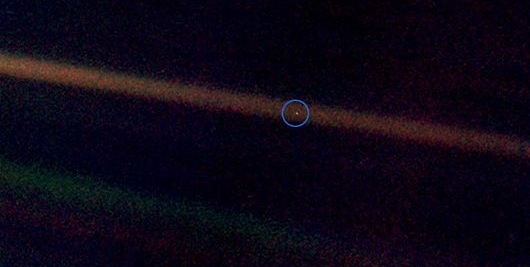As the number of discovered extrasolar planets grows, astronomers begin looking at the next step: finding rocky Earth-like planets. In addition, astronomers would ideally like to block out the parent star and detect some of the reflected glow from the planet’s atmosphere in an attempt to characterize the chemical makeup. But what would an “Earth-like” planet’s reflected light look like? To answer this, a new paper explores what Earth should have looked like at various points in our planet’s history.
Currently, astronomers have a good understanding on how our planet reflects light. Even before satellites were launched that could observe this directly, we could see the reflected light from our home on the moon, an effect known as “Earthshine”. The amount of light reflected depends on what’s on the surface.
The paper considers five different types of reflecting materials. Water and vegetation tend to be strong absorbers of light at visible and ultraviolet wavelengths whereas ice and deserts are highly reflective. The amount of cloud cover, which also reflects a good deal of light, is the fifth.
With the modern Earth, our planet currently reflects about 32% of all incoming light. This changes by a few percent depending on the season, depending mostly on the amount of cloud cover.
This new study also analyzes what the amount of reflected light should have been for Earth, known as its albedo, during four other historical periods: the Late Cretaceous (90 million years ago), the Late Triassic (230 My ago), the Mississippian (340 My ago), and the Late Cambrian (500 My ago).
Using simulations based on the various surface features, the team from the Instituto de Astrofísica de Canarias owned by Spain, the team reconstructed the expected amount of cloud cover for these various epochs to consider their contributions to the overall albedo.
In general, the historical periods had strikingly similar amounts of reflectiveness due to “similar ocean-land-vegitation distribution” as well as similar distributions of continents between hemispheres and most deserts in low latitudes. The exception to this, was the Late Cambrian. While the average was only slightly higher, this period varied depending on which portion of the Earth was viewed.
At that time, the original supercontinent, Pangea was in the process of breaking up. They were still clustered and almost exclusively in the southern hemisphere. The sea levels were also significantly higher meaning a larger portion of land was submerged, covered by the non-reflective water. Lastly, most of the life was still concentrated in the oceans. Since it had not yet advanced to land, it is expected that the surface was mostly rocky desert terrain which would have high reflectivity. During the times when the breaking up supercontinent was facing an observer, the albedo would jump to as much as 37% only to sink to 32% when it rotated from view.
The team suggests that such a variation may allow astronomers to determine the rotation rates of planets in the future. In an ideal situation, it may even give clues to the geographical arrangement of continents.


Thank you!
Sometimes these things are very timely. I was lead to the upcoming Habitable Exoplanets Catalog yesterday. Being a fan of Méndez Standard Primary Habitability index I glanced at the updates, and became concerned about the SPH variation (fig 5) and how it would affect detectability.
Of course as one can see from the figure, while SPH is a good median term predictor, the outcome vegetation abundance is less variable for some unknown reason. (Life tends to be a robust phenomena.) Nice to see that confirmed elsewhere.
[As they note there, there are several questions on SPH and similar measures that needs to be addressed to assess habitability and its observation. (SPH can in principle be calculated from spectral observations of temperature and water abundance.)
That vegetation or its absence can be observed directly in extreme cases, such as it seems here, helps!]
Thank you!
Sometimes these things are very timely. I was lead to the upcoming Habitable Exoplanets Catalog yesterday. Being a fan of Méndez Standard Primary Habitability index I glanced at the updates, and became concerned about the SPH variation (fig 5) and how it would affect detectability.
Of course as one can see from the figure, while SPH is a good median term predictor, the outcome vegetation abundance is less variable for some unknown reason. (Life tends to be a robust phenomena.) Nice to see that confirmed elsewhere.
[As they note there, there are several questions on SPH and similar measures that needs to be addressed to assess habitability and its observation. (SPH can in principle be calculated from spectral observations of temperature and water abundance.)
That vegetation or its absence can be observed directly in extreme cases, such as it seems here, helps!]